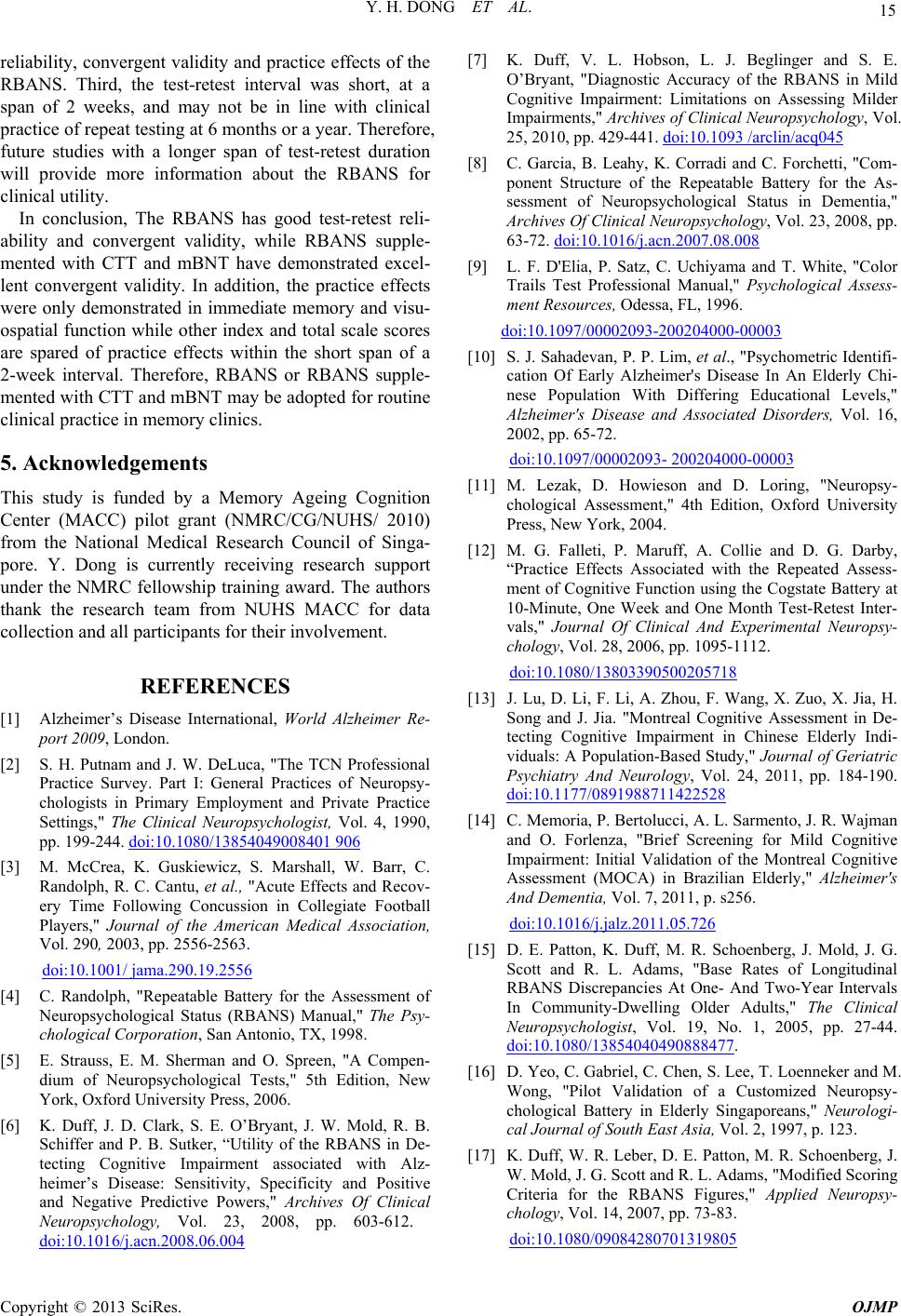
Y. H. DONG ET AL. 15
reliability, convergent validity and practice effects of the
RBANS. Third, the test-retest interval was short, at a
span of 2 weeks, and may not be in line with clinical
practice of repeat testing at 6 months or a year. Therefore,
future studies with a longer span of test-retest duration
will provide more information about the RBANS for
clinical utility.
In conclusion, The RBANS has good test-retest reli-
ability and convergent validity, while RBANS supple-
mented with CTT and mBNT have demonstrated excel-
lent convergent validity. In addition, the practice effects
were only demonstrated in immediate memory and visu-
ospatial function while other index and total scale scores
are spared of practice effects within the short span of a
2-week interval. Therefore, RBANS or RBANS supple-
mented with CTT and mBNT may be adopted for routine
clinical practice in memory clinics.
5. Acknowledgements
This study is funded by a Memory Ageing Cognition
Center (MACC) pilot grant (NMRC/CG/NUHS/ 2010)
from the National Medical Research Council of Singa-
pore. Y. Dong is currently receiving research support
under the NMRC fellowship training award. The authors
thank the research team from NUHS MACC for data
collection and all participants for their involvement.
REFERENCES
[1] Alzheimer’s Disease International, World Alzheimer Re-
port 2009, London.
[2] S. H. Putnam and J. W. DeLuca, "The TCN Professional
Practice Survey. Part I: General Practices of Neuropsy-
chologists in Primary Employment and Private Practice
Settings," The Clinical Neuropsychologist, Vol. 4, 1990,
pp. 199-244. doi:10.1080/13854049008401 906
[3] M. McCrea, K. Guskiewicz, S. Marshall, W. Barr, C.
Randolph, R. C. Cantu, et al., "Acute Effects and Recov-
ery Time Following Concussion in Collegiate Football
Players," Journal of the American Medical Association,
Vol. 290, 2 003, pp. 2556-256 3.
doi:10.1001/ jama.290.19.2556
[4] C. Randolph, "Repeatable Battery for the Assessment of
Neuropsychological Status (RBANS) Manual," The Psy-
chological Corporation, San Antonio, TX, 1998.
[5] E. Strauss, E. M. Sherman and O. Spreen, "A Compen-
dium of Neuropsychological Tests," 5th Edition, New
York, Oxford University Press, 2006.
[6] K. Duff, J. D. Clark, S. E. O’Bryant, J. W. Mold, R. B.
Schiffer and P. B. Sutker, “Utility of the RBANS in De-
tecting Cognitive Impairment associated with Alz-
heimer’s Disease: Sensitivity, Specificity and Positive
and Negative Predictive Powers," Archives Of Clinical
Neuropsychology, Vol. 23, 2008, pp. 603-612.
doi:10.1016/j.acn.2008.06.004
[7] K. Duff, V. L. Hobson, L. J. Beglinger and S. E.
O’Bryant, "Diagnostic Accuracy of the RBANS in Mild
Cognitive Impairment: Limitations on Assessing Milder
Impairments," Archives of Clinical Neuropsychology, Vol.
25, 2010, pp. 429-441. doi:10.1093 /arclin/acq045
[8] C. Garcia, B. Leahy, K. Corradi and C. Forchetti, "Com-
ponent Structure of the Repeatable Battery for the As-
sessment of Neuropsychological Status in Dementia,"
Archives Of Clinical Neuropsychology, Vol. 23, 2008, pp.
63-72. doi:10.1016/j.acn.2007.08.008
[9] L. F. D'Elia, P. Satz, C. Uchiyama and T. White, "Color
Trails Test Professional Manual," Psychological Assess-
ment Resources, Odessa, FL, 1996.
doi:10.1097/00002093-200204000-00003
[10] S. J. Sahadevan, P. P. Lim, et al., "Psychometric Identifi-
cation Of Early Alzheimer's Disease In An Elderly Chi-
nese Population With Differing Educational Levels,"
Alzheimer's Disease and Associated Disorders, Vol. 16,
2002, pp. 65-72.
doi:10.1097/00002093- 200204000-00003
[11] M. Lezak, D. Howieson and D. Loring, "Neuropsy-
chological Assessment," 4th Edition, Oxford University
Press, New York, 2004.
[12] M. G. Falleti, P. Maruff, A. Collie and D. G. Darby,
“Practice Effects Associated with the Repeated Assess-
ment of Cognitive Function using the Cogstate Battery at
10-Minute, One Week and One Month Test-Retest Inter-
vals," Journal Of Clinical And Experimental Neuropsy-
chology, Vol. 28, 2006, pp. 1095-1112.
doi:10.1080/13803390500205718
[13] J. Lu, D. Li, F. Li, A. Zhou, F. Wang, X. Zuo, X. Jia, H.
Song and J. Jia. "Montreal Cognitive Assessment in De-
tecting Cognitive Impairment in Chinese Elderly Indi-
viduals: A Population-Based Study," Journal of Geriatric
Psychiatry And Neurology, Vol. 24, 2011, pp. 184-190.
doi:10.1177/0891988711422528
[14] C. Memoria, P. Bertolucci, A. L. Sarmento, J. R. Wajman
and O. Forlenza, "Brief Screening for Mild Cognitive
Impairment: Initial Validation of the Montreal Cognitive
Assessment (MOCA) in Brazilian Elderly," Alzheimer's
And Dementia, Vol. 7, 2011, p. s256.
doi:10.1016/j.jalz.2011.05.726
[15] D. E. Patton, K. Duff, M. R. Schoenberg, J. Mold, J. G.
Scott and R. L. Adams, "Base Rates of Longitudinal
RBANS Discrepancies At One- And Two-Year Intervals
In Community-Dwelling Older Adults," The Clinical
Neuropsychologist, Vol. 19, No. 1, 2005, pp. 27-44.
doi:10.1080/13854040490888477.
[16] D. Yeo, C. Gabriel, C. Chen, S. Lee, T. Loenneker and M.
Wong, "Pilot Validation of a Customized Neuropsy-
chological Battery in Elderly Singaporeans," Neurologi-
cal Journal of South East Asia, Vol. 2, 1997, p. 123.
[17] K. Duff, W. R. Leber, D. E. Patton, M. R. Schoenberg, J.
W. Mold, J. G. Scott and R. L. Adams, "Modified Scoring
Criteria for the RBANS Figures," Applied Neuropsy-
chology, Vol. 14, 2007, pp. 73-83.
doi:10.1080/09084280701319805
Copyright © 2013 SciRes. OJMP